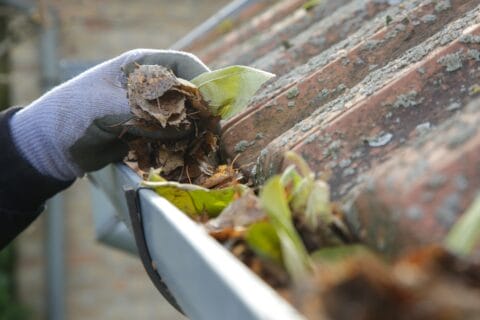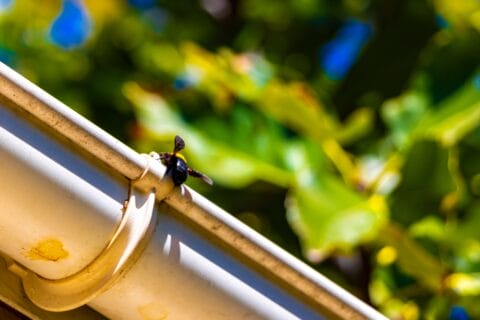How to Replace Eavestroughs: A Complete Homeowner’s Guide
 Revised by Bruce Hulse
Revised by Bruce Hulse
Replacing your eavestrough, also known as a gutter, is one of the most important steps in protecting your home from water damage. This system directs rainwater away from your roof, walls, and foundation, ensuring your house remains dry and structurally sound. In Ottawa, where seasonal weather brings heavy rain in spring and significant snowmelt in winter, a well-installed eavestrough system is especially critical. Gutters that are clogged, sagging, or broken can cause water to back up into roofing materials or seep into basements, leading to long-term issues that are both costly and disruptive. Replacing them at the right time ensures your property remains protected year after year.
Essential Points at a Glance
| Aspect | Key Points |
| Purpose of Eavestroughs | Direct water away from roof, walls, and foundation to prevent water damage. |
| Tools & Materials Needed | Ladder, chalk line, gutter sections, fasteners, sealant, downspout adapter, saws, drill/driver. |
| DIY vs Professional | DIY saves money but requires skill; professionals ensure precision and safety. |
| Material Choices | Aluminum and vinyl are affordable and durable; copper is premium and long-lasting. |
| Installation Essentials | Maintain proper slope (¼ inch every 10 feet); downspouts every 20–30 feet. |
| Maintenance Tips | Inspect regularly for leaks, sagging, and clogs; consider leaf guards and rain barrels. |
Understanding Eavestroughs and Their Importance
Eavestroughs may seem like a small part of your home’s exterior, but they play a big role in protecting your property. By collecting rainwater and channeling it away from the structure, they prevent roof leaks, basement flooding, and soil erosion. Without a functioning gutter system, water can pool near the foundation, leading to cracks and costly repairs. They also help preserve exterior finishes like siding and brick by keeping moisture from constantly running down the walls.
In climates like Ottawa’s, the freeze-thaw cycle and buildup of ice can place additional stress on gutters. Heavy snowfall and spring thaw can overwhelm older systems if they are improperly sloped or partially clogged. Replacing old or damaged eavestroughs before they fail can save homeowners from extensive damage later. Properly working gutters also help protect landscaping, driveways, and walkways from being eroded or undermined by uncontrolled water flow.
Tools and Materials for Eavestrough Replacement
A successful replacement project starts with the right tools and materials. At minimum, you will need:
- Ladder for safe access to rooflines. Make sure it’s sturdy and positioned on level ground.
- Chalk line to mark a consistent slope across the fascia boards.
- Gutter sections in your chosen material (aluminum, vinyl, or copper). Select lengths and styles that suit your home.
- Fasteners and hangers to secure the system in place and support weight during heavy rainfall or snowfall.
- Downspout adapter and pipes to direct water away from the home’s foundation and reduce the risk of pooling.
- Sealant for end caps, joints, and corners to prevent leaks.
- Cutting tools such as a hacksaw or miter saw for fitting sections.
- Drill/driver and rivet gun for fastening connections securely.
Gathering these items before you begin avoids mid-project delays and ensures a smoother installation process. If you’re attempting the project yourself, investing in proper safety gear such as gloves, protective eyewear, and non-slip shoes is also recommended.
Removing Old Eavestroughs
Before installing new gutters, the old ones must be removed carefully. Start at a corner, unscrew or pry away fasteners, and detach each section while supporting the joints to avoid sudden drops. Collect and responsibly dispose of the old eavestroughs. Many metal gutters can be recycled, making the process more eco-friendly and reducing waste sent to landfill.
It’s also a good opportunity to inspect the fascia boards and soffits for signs of rot or water damage. If the wood underneath is soft, discoloured, or cracked, it should be repaired before new gutters are installed. Replacing gutters without addressing underlying structural problems may shorten the lifespan of your new system. In Ottawa’s climate, where snow and ice can push against fascia boards, ensuring the underlying structure is strong is especially important.
Measuring and Planning for New Gutters
Accurate measurements are essential for a reliable installation. Measure the entire roofline where gutters will be installed, including corners and overhangs. It’s wise to purchase about 10% more material than calculated, since mistakes or trimming adjustments are common and it prevents delays mid-project.
Also determine downspout placement at this stage. A good rule of thumb is one downspout every 20 to 30 feet of guttering, positioned where water can be directed away from the foundation into a safe drainage area. Consider where water naturally flows on your property and avoid directing it toward walkways or driveways, where pooling could create icy patches in winter. Proper planning makes installation smoother and helps ensure water management is effective.
Step-by-Step Installation Guide
Installing new eavestroughs requires patience and precision. The process involves multiple steps:
- Mark the slope using a chalk line, with a downward pitch of ¼ inch every 10 feet toward the downspout. This ensures gravity naturally directs water.
- Assemble sections on the ground before lifting them. Connectors, elbows, and end caps are easier to attach at ground level than when balancing on a ladder.
- Lift and fasten the assembled gutters along the fascia, securing them every 18–24 inches with hangers. Tighter spacing may be required in areas with heavier snow.
- Attach downspouts with adapters, ensuring they extend several feet away from the house to prevent pooling near the foundation.
- Seal joints with gutter sealant to eliminate leaks. Apply generously at end caps, corners, and seams.
- Test the system by running water through it with a hose, checking for leaks, sagging, or overflow. Make adjustments before the next rainfall.
For homes in snowy regions like Ottawa, placing hangers closer together provides additional strength to handle snow loads and prevent sagging. Taking the time to carefully test and adjust during installation pays off in the long run.
Choosing the Right Eavestrough Material
| Material | Advantages | Considerations |
| Aluminum | Lightweight, rust-resistant, durable, and easy to maintain. Suitable for most climates. | Can dent under heavy impact. |
| Vinyl | Easy to install, inexpensive, and available in many colours. Does not rust. | Can crack in extreme cold or warp under strong sun. |
| Copper | Extremely durable, elegant appearance, rust-proof, and can last for decades. | Higher upfront investment; develops natural patina over time. |
For most Ottawa homeowners, aluminum offers the best balance between cost, durability, and weather resistance. Vinyl is a suitable option for smaller projects, but Ottawa’s cold winters may shorten its lifespan. Copper, while premium, is often chosen for aesthetic appeal on historic or custom homes.
DIY vs Professional Installation
Replacing gutters on your own can reduce labour costs, but it comes with challenges:
- DIY Pros: Lower initial cost, flexibility to work at your own pace, personal satisfaction of completing the project.
- DIY Cons: Requires ladder safety, precise measurements, and installation knowledge. Mistakes can lead to water pooling, leaks, or damage to siding and foundation.
Hiring a professional ensures correct slope, secure fastening, and long-term performance. Professionals have the experience to spot issues such as fascia rot or improper roof drainage that homeowners might overlook. For complex rooflines, multi-story houses, or homeowners concerned about safety, professional installation is strongly recommended. In Ottawa, where weather conditions can be demanding, professional expertise adds an extra layer of reliability.
Ensuring Proper Water Flow
Two critical aspects of performance are slope and drainage:
- Optimal Slope: ¼ inch drop for every 10 feet of guttering. For runs over 40 feet, slope from the centre toward both ends or from ends toward the middle. This prevents pooling and ensures consistent drainage.
- Downspout Placement: Install one downspout every 20–30 feet to prevent overflow. Downspouts should extend away from the foundation or connect to drainage systems.
Ignoring these guidelines can lead to pooling water, structural damage, and ice buildup in winter. Proper slope also prevents standing water, which can attract mosquitoes in summer. Taking the time to ensure drainage is effective keeps the system efficient year-round.
Maintenance for Long-Lasting Gutters
Proper maintenance extends the life of your eavestroughs and protects your home:
- Inspections: Check gutters twice yearly, ideally in spring and fall, for leaks, clogs, sagging, or sections pulling away from the fascia.
- Cleaning: Remove leaves, pine needles, and debris regularly to prevent overflow. In Ottawa, fall is a particularly important time due to leaf drop.
- Safety: Use a sturdy ladder, wear gloves, and avoid working alone. Consider using scaffolding for large projects.
Additional Enhancements
- Leaf guards: Help prevent clogs if your home is surrounded by trees. They reduce cleaning frequency but still require occasional maintenance.
- Rain barrels: Connect to downspouts to collect water for gardening, car washing, or other outdoor tasks. This eco-friendly option helps conserve water and can reduce utility bills.
- Heated gutter cables: For Ottawa homes, these can reduce ice damming by keeping water moving during freeze-thaw cycles.
Conclusion: Protecting Your Home with Proper Gutter Care
Replacing your eavestrough is a vital investment in maintaining your home’s integrity. With proper installation and regular upkeep, you can safeguard your roof, walls, and foundation from water damage for years to come. While many homeowners attempt DIY projects, professional services provide peace of mind and ensure the system performs under Ottawa’s demanding weather conditions.
If you’re looking for expert help, Clear Ottawa Windows offers professional gutter solutions tailored to local homeowners’ needs. Their team ensures reliable installation and maintenance, keeping your property protected through every season.


